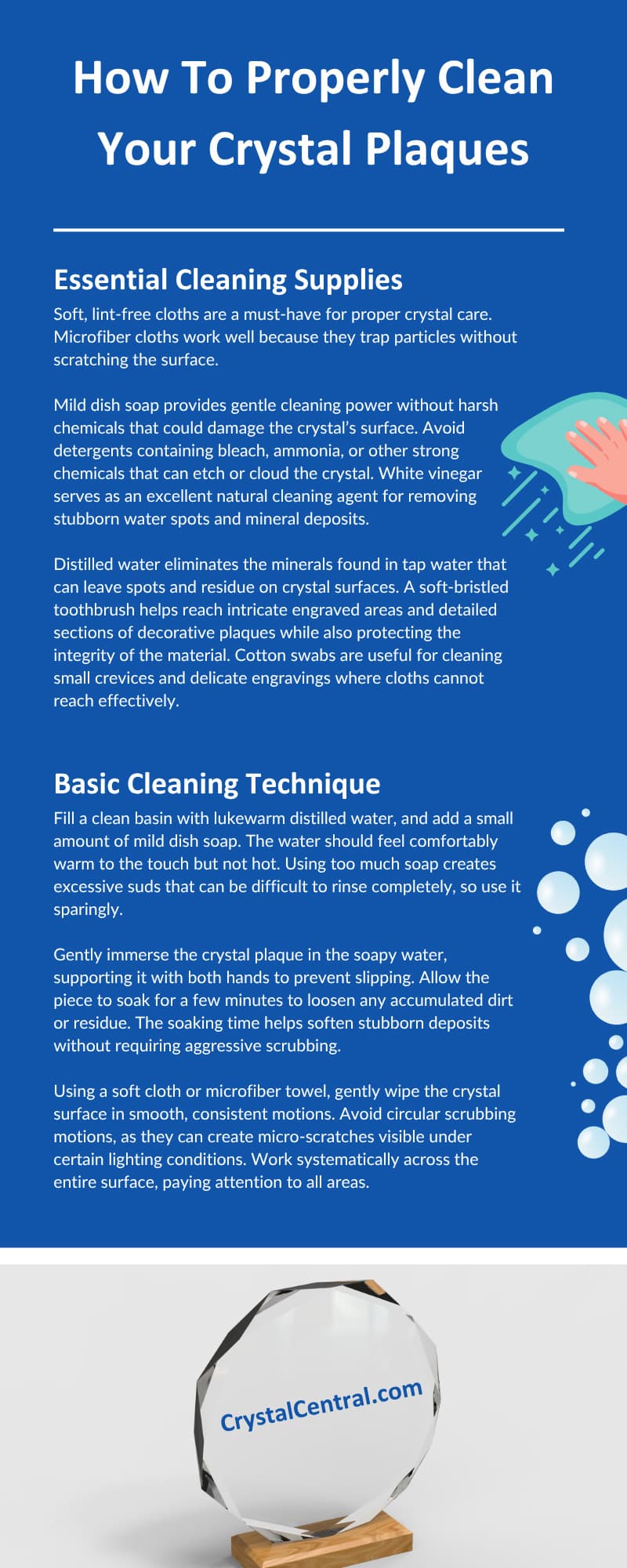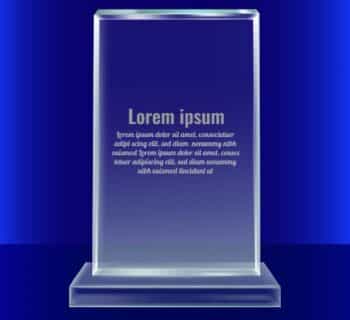Crystal plaques are more than mere decorative pieces—they also embody cherished memories, achievements, and moments worth preserving for generations. These elegant awards and commemorative pieces deserve meticulous care to maintain their brilliance and clarity.
Knowing how to properly clean your crystal plaques helps you protect your investment and preserve the sentimental value these pieces hold. Crystal’s unique properties necessitate specialized approaches that differ from those used for cleaning glass or other materials. The following information will help you maintain the pristine condition of your crystal plaques, guaranteeing they will remain stunning focal points in your home or office for years to come.
Understanding Crystal Composition
Crystal plaques contain lead oxide, which gives them their distinctive weight, clarity, and light-refracting properties. This composition makes crystal more delicate than regular glass, so it requires gentle handling and specific cleaning methods. The lead content creates the beautiful sparkle and brilliance that makes crystal plaques so captivating, but it also means harsh chemicals and abrasive materials can cause permanent damage.
Extreme temperature changes can cause cracking or stress fractures in the material. Room-temperature water works best for cleaning, as hot water can shock the crystal, while cold water may not effectively remove all residue. Understanding these fundamental properties helps you approach cleaning with the appropriate level of care and attention.
Essential Cleaning Supplies
Soft, lint-free cloths are a must-have for proper crystal care. Microfiber cloths work well because they trap particles without scratching the surface.
Mild dish soap provides gentle cleaning power without harsh chemicals that could damage the crystal’s surface. Avoid detergents containing bleach, ammonia, or other strong chemicals that can etch or cloud the crystal. White vinegar serves as an excellent natural cleaning agent for removing stubborn water spots and mineral deposits.
Distilled water eliminates the minerals found in tap water that can leave spots and residue on crystal surfaces. A soft-bristled toothbrush helps reach intricate engraved areas and detailed sections of decorative plaques while also protecting the integrity of the material. Cotton swabs are useful for cleaning small crevices and delicate engravings where cloths cannot reach effectively.
Basic Cleaning Technique
Fill a clean basin with lukewarm distilled water, and add a small amount of mild dish soap. The water should feel comfortably warm to the touch but not hot. Using too much soap creates excessive suds that can be difficult to rinse completely, so use it sparingly.
Gently immerse the crystal plaque in the soapy water, supporting it with both hands to prevent slipping. Allow the piece to soak for a few minutes to loosen any accumulated dirt or residue. The soaking time helps soften stubborn deposits without requiring aggressive scrubbing.
Using a soft cloth or microfiber towel, gently wipe the crystal surface in smooth, consistent motions. Avoid circular scrubbing motions, as they can create micro-scratches visible under certain lighting conditions. Work systematically across the entire surface, paying attention to all areas.
Removing Stubborn Stains and Deposits
Water spots and mineral deposits often require additional attention beyond basic cleaning. Create a solution of equal parts white vinegar and distilled water for these persistent marks. The mild acidity of vinegar dissolves mineral deposits without damaging the crystal surface.
Apply the vinegar solution using a soft cloth, focusing on affected areas. Allow the solution to sit for several minutes before gently wiping it away. For particularly stubborn deposits, you may need to repeat this process several times.
Fingerprints and oils from handling often leave visible marks on crystal surfaces. These organic residues respond well to the basic soap and water method but may require slightly longer soaking times. The key lies in gentle persistence rather than aggressive scrubbing.
Cleaning Engraved Areas
Engraved portions of crystal plaques require special attention due to their intricate details and recessed areas. A soft-bristled toothbrush is a good tool to use on these detailed areas.
Dip the toothbrush in the soapy water solution, and gently work it into the engraved areas using light, careful strokes. The bristles should be soft enough to avoid scratching while firm enough to dislodge accumulated debris. Work slowly and methodically to ensure thorough cleaning.
Cotton swabs moistened with cleaning solution help reach the finest details and smallest crevices. These tools allow precise cleaning of intricate engravings without risking damage to surrounding areas. Take your time with these detailed sections, as they often represent the most meaningful aspects of commemorative plaques.
Proper Rinsing Methods
Thorough rinsing removes all soap residue and cleaning solutions that could leave films or spots on the crystal surface. Use clean, lukewarm distilled water for rinsing, maintaining the same temperature as the cleaning water to avoid thermal shock.
Rinse the entire plaque systematically, ensuring water reaches all cleaned areas, including engraved sections. Pay particular attention to detailed areas where soap residue might linger. Insufficient rinsing can leave films that dull the crystal’s natural brilliance.
Drying Techniques
Use clean, lint-free cloths to pat the crystal dry rather than wiping, which can leave streaks or lint particles. Start with areas that collect water, such as engraved sections or decorative details. Work systematically to ensure complete drying.
Air drying completes the process, allowing any remaining moisture to evaporate naturally. Place the plaque on a soft, clean surface away from direct sunlight or heat sources. Proper air circulation helps prevent water spots while maintaining safe conditions for the crystal.
Maintaining Crystal Brilliance
Regular maintenance keeps crystal plaques looking their best between thorough cleanings. Dust the surface weekly using a soft, dry cloth to prevent accumulation that can dull the finish. Handle crystal plaques with clean hands whenever possible to minimize the transfer of oil and fingerprints. When handling cannot be avoided, clean your hands first to reduce the frequency of deep cleaning required.
Proper storage protects crystal plaques from dust and damage when they are not on display. Wrap the piece in soft cloth or tissue paper, avoiding materials that might transfer ink or chemicals, such as newspaper. Store in stable temperature conditions, away from anything that might fall or bump into it.
Professional Care Considerations
Beyond knowing how to properly clean your crystal plaques yourself, you’ll also want to know other ways to incorporate maintenance. For example, some crystal plaques may require professional restoration or specialized cleaning due to age, damage, or extreme tarnishing.
Professional crystal restoration services use specialized tools and expertise to handle severely damaged or antique pieces. When in doubt, seek professional help rather than risking damage through inappropriate home cleaning attempts. Cracks, chips, or clouding that doesn’t respond to gentle cleaning methods indicate the need for expert intervention. Crystal Central provides guidance and support for maintaining your personalized crystal awards or plaques and keeping them in optimal condition.







